Étiquette : Mozart
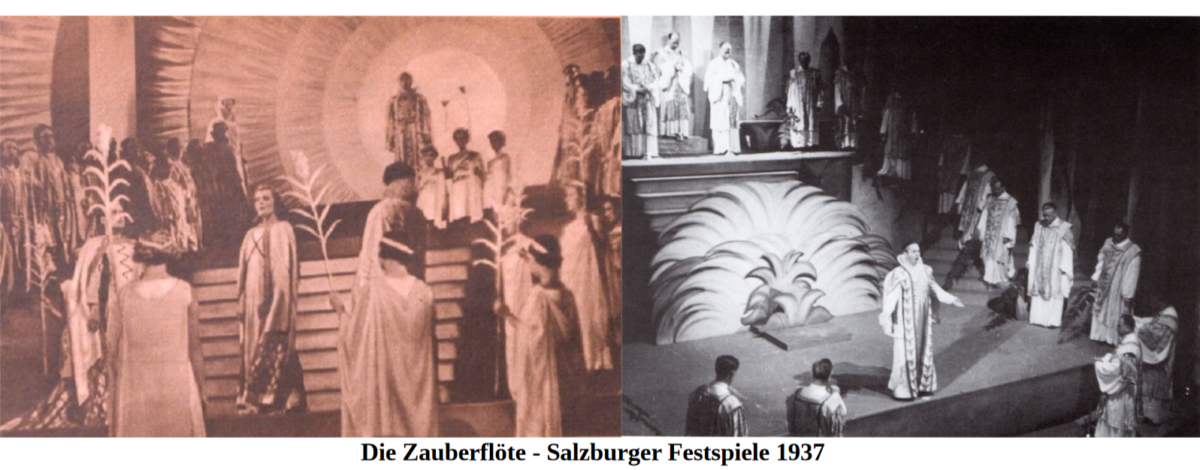
Kipnis – Mozart Verdi Wagner 1916-1937
Alexander Kipnis: Airs d’Opéra /Opera Arias
Source 33t/LP: Pearl GEMM 277/8

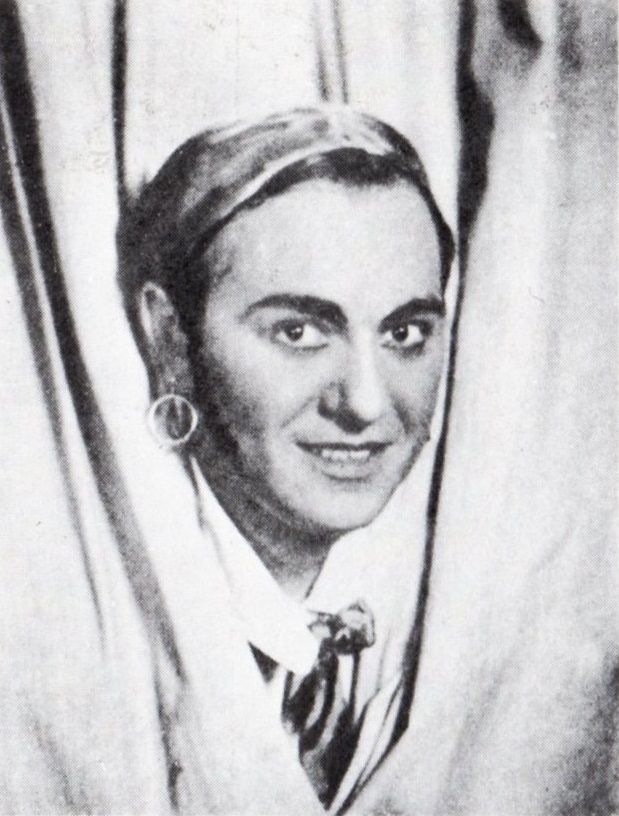
Le Nozze di Figaro: Kipnis (Figaro)
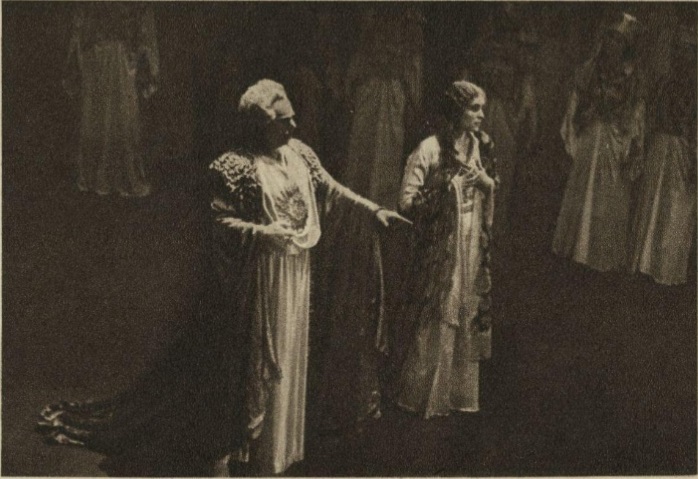
Die Zauberflöte: Kipnis (Sarastro) 1937: Salzburger Festspiele (avec/with Jarmila Novotna)
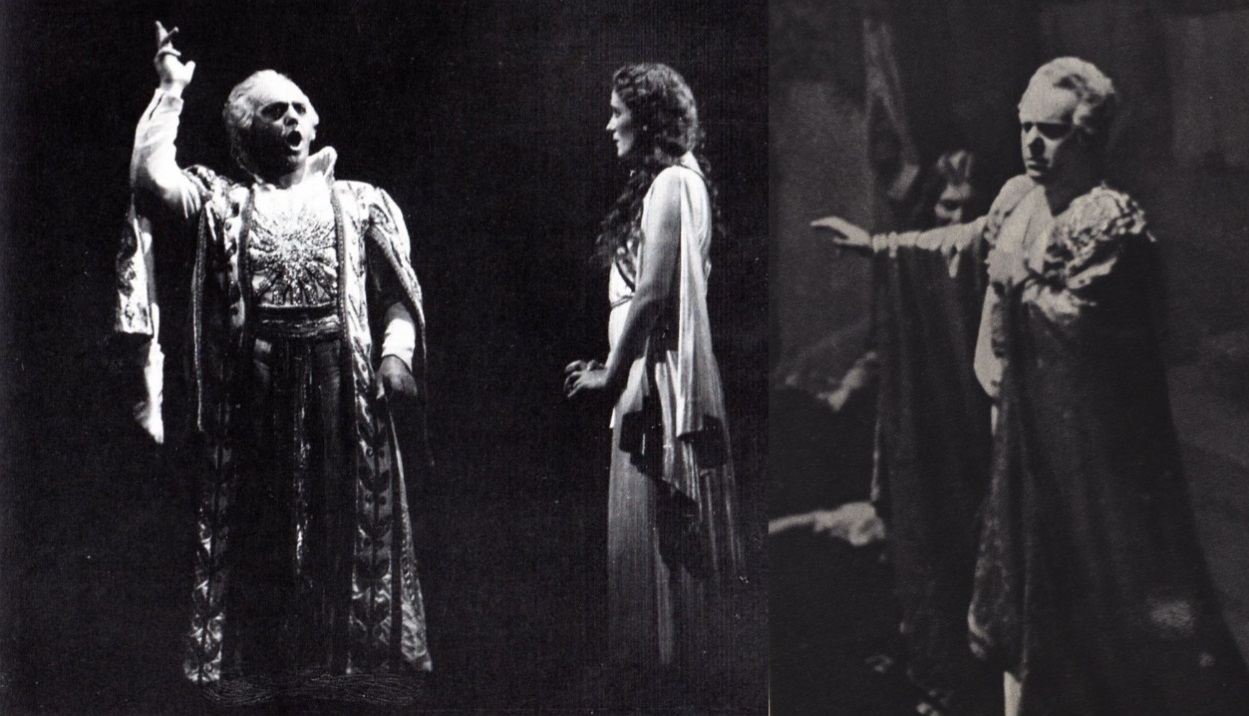
Die Zauberflöte: Kipnis (Sarastro) 1937: Salzburger Festspiele (avec/with Jarmila Novotna) – Wiener Staatsoper
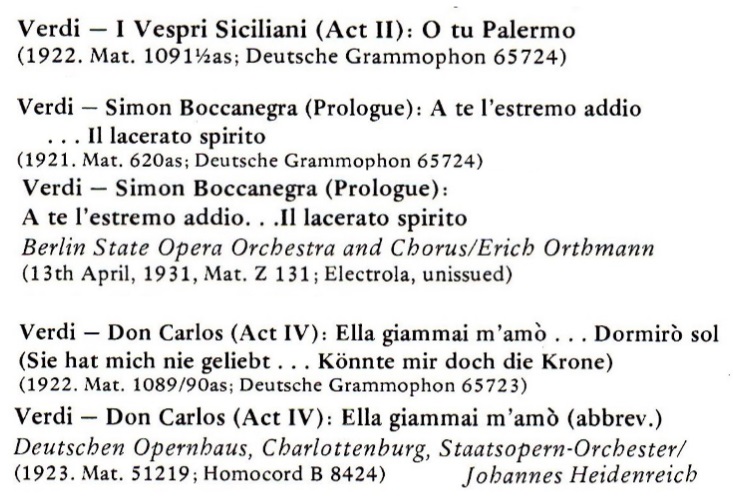
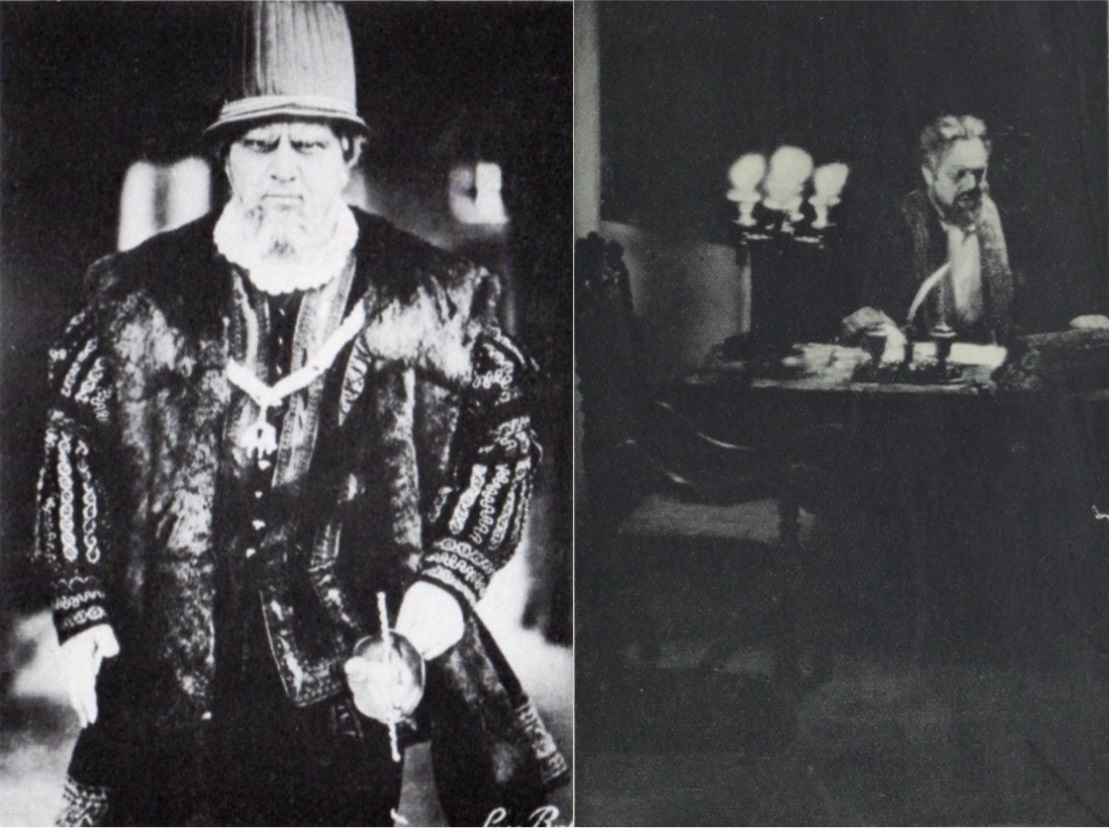
Don Carlos: Kipnis (Philipp II): Berlin (1931) – Wiener Staatsoper (1937)
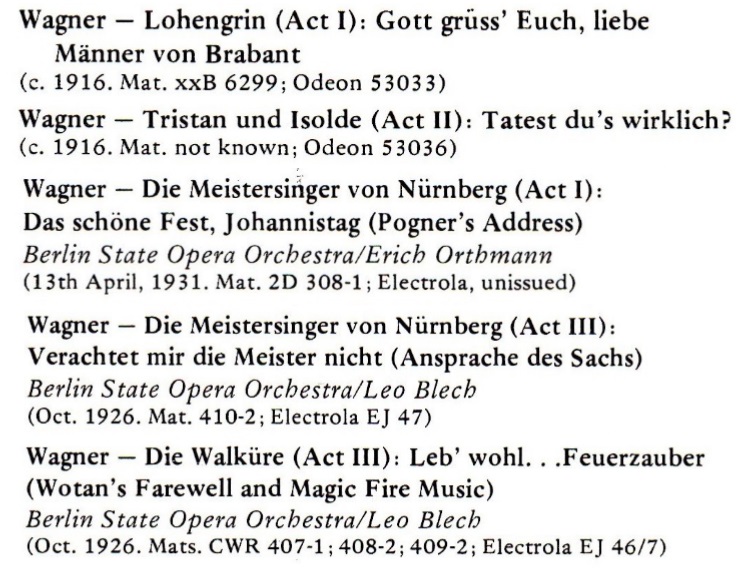
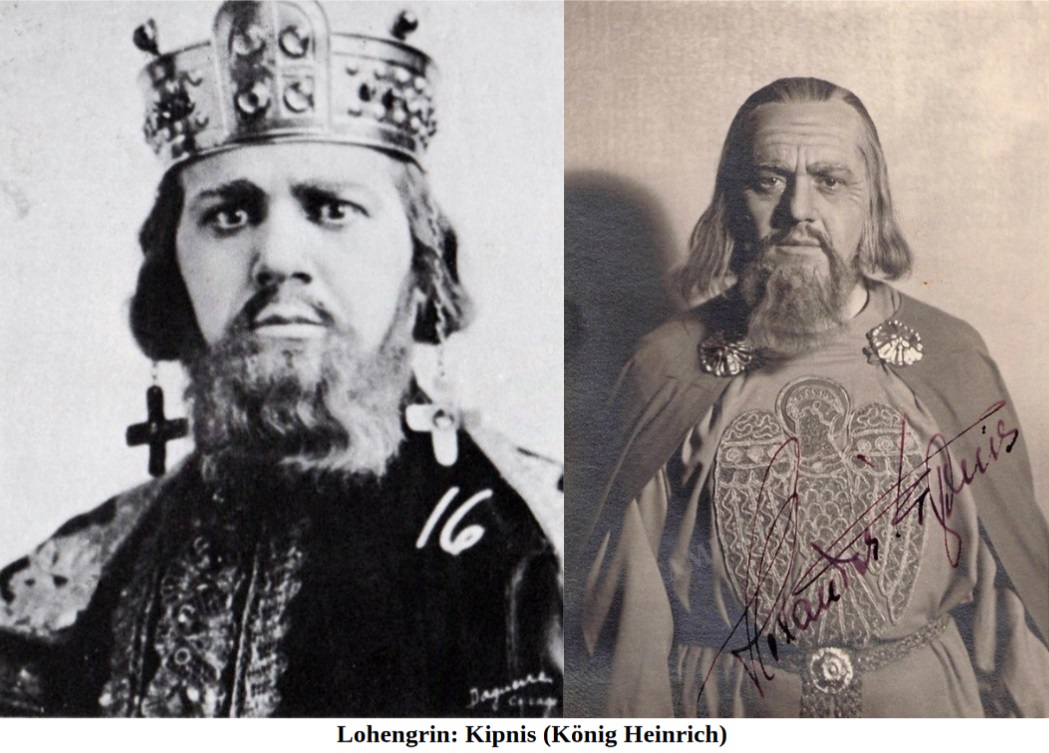
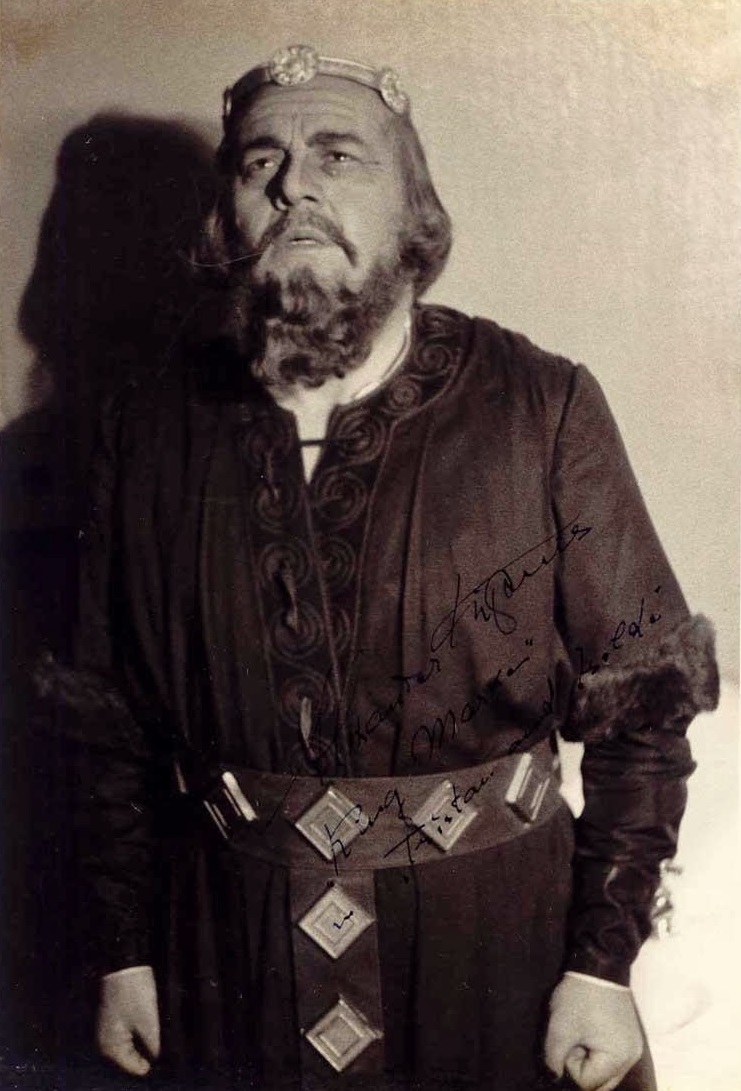
Tristan und Isolde: Kipnis (König Marke)

En 1984, la firme Pearl a publié un Album de deux disques 33 tours (GEMM 277/8) consacré à Alexander Kipnis (1891-1978). Le producteur était le fils du chanteur, le claveciniste Igor Kipnis, et il a fait appel aux services de la ‘Yale Collection of Historical Sound Recordings’. La sélection d’enregistrements effectués entre 1916 (au moment où Kipnis avait été engagé par l’opéra de Hambourg), et 1937 (juste avant ses dernières apparitions en Autriche), nous montre d’une part, qu’en 1916, la voix possédait déjà l’essentiel de ses qualités, et d’autre part, qu’elle a toujours été extrêmement phonogénique, au point que même les enregistrements les plus anciens restituent son timbre et ses nuances d’interprétation. Il faut dire que le soin apporté aux reports y a certainement sa part.
La présente sélection d’airs d’opéras montre tout d’abord Kipnis dans trois rôles de Mozart qu’il chante en allemand, à savoir Bartolo avec l’air ‘la Vendetta’, Figaro avec l’air ‘Aprite un po’, et enfin Sarastro, dont les deux airs sont donnés dans l’enregistrement public du Festival de Salzburg 1937 sous la direction de Toscanini. L’air ‘In diesen heil’gen Hallen’ bénéficie également d’une version enregistrée aux États-Unis en 1929 sous la direction de Robert Hood Bowers. Ce ‘doublon’, au tempo plus modéré, permet de mieux rendre compte de l’interprétation de Kipnis qu’avec le tempo rapide choisi par Toscanini.
De Verdi, Kipnis chante dans la langue originale l’air de Procida de ‘I Vespri Siciliani’, ainsi que deux versions de l’air de Fiesco ‘Il lacerato spirito’ de ‘Simon Boccanegra’(1921 et 1931), alors que pour l’air de Philippe II ‘Ella giammai m’amo’ de Don Carlos, la première de 1922, sur deux faces de 78 tours est en allemand, et la deuxième, réalisée l’année suivante, est abrégée et dans un tempo un peu trop rapide, mais est cette fois dans la langue originale.
Le programme Wagner débute par l’air du roi Heinrich ‘Gott gruss’ Euch, liebe Männer von Brabant‘ de Lohengrin, rôle que Kipnis chanta 85 fois de 1915 à 1936, avec ensuite l’air du Roi Marke ‘Tatest du’s wirklich’ de Tristan und Isolde‘ (1916), rôle qu’il a chanté pour la première fois en 1917 à l’Opéra de Wiesbaden, et qui l’a accompagné tout le long de sa carrière. Deux airs des Meistersinger ‘Das schöne Fest, Johannistag’ (Pogner) et ‘Verachtet mir die Meister nicht’ (Sachs) font suite et pour conclure nous avons les Adieux de Wotan ‘Leb’ wohl, du kühnes…’. Les deux derniers airs bénéficient de la direction de Leo Blech, alors Generalmusikdirektor (GMD) du Berliner Staatsoper.
____________
In 1984, Pearl released a two-disc LP album (GEMM 277/8) devoted to Alexander Kipnis (1891-1978). The producer was the singer’s son, harpsichordist Igor Kipnis, and he called on the services of the Yale Collection of Historical Sound Recordings. The selection of recordings made between 1916 (when Kipnis was engaged by the Hamburg Opera) and 1937 (just before his last appearances in Austria) shows us that, in 1916, the voice already possessed most of its qualities, and that it has always been extremely phonogenic, to the extent that even the oldest recordings reproduce its timbre and the nuances of the interpretation. It has to be said that the care taken with the transfers has certainly played its part.
The present selection of opera arias first shows Kipnis in three Mozart roles that he sings in German, namely Bartolo with the aria ‘La Vendetta’, Figaro with the aria ‘Aprite un po’, and finally Sarastro, both arias of which are given in the public recording of the 1937 Salzburg Festival conducted by Toscanini. The aria ‘In diesen heil’gen Hallen’ was also recorded in the United States in 1929 under Robert Hood Bowers. This ‘duplicate’, at a more moderate tempo, gives a better account of Kipnis’s interpretation than the one with the fast tempo chosen by Toscanini.
Kipnis sings Verdi’s Procida aria from ‘I Vespri Siciliani’ in the original language, as well as two versions of Fiesco’s aria ‘Il lacerato spirito’ from ‘Simon Boccanegra’ (1921 and 1931). In the case of Philip II’s aria ‘Ella giammai m’amo’ from Don Carlos, the first, from 1922, on two 78-rpm sides is in German, and the second, made the following year, is abridged and with a rather too fast tempo, but this time in the original language.
The Wagner programme opens with König Heinrich’s aria ‘Gott gruss’ Euch, liebe Männer von Brabant’ from Lohengrin, a role that Kipnis sang 85 times between 1915 and 1936, followed by King Marke’s aria ‘Tatest du’s wirklich’ from Tristan und Isolde’ (1916), a role he sang for the first time in 1917 at the Wiesbaden Opera House and that accompanied him throughout his career. Two arias from the Meistersinger ‘Das schöne Fest, Johannistag’ (Pogner) and ‘Verachtet mir die Meister nicht’ (Sachs) follow and to conclude we have Wotan’s Farewell ‘Leb’ wohl, du kühnes…’. Worth mentioning is that the last two arias are conducted by Leo Blech, then Generalmusikdirektor (GMD) of the Berliner Staatsoper.
Les liens de téléchargement sont dans le premier commentaire. The download links are in the first comment
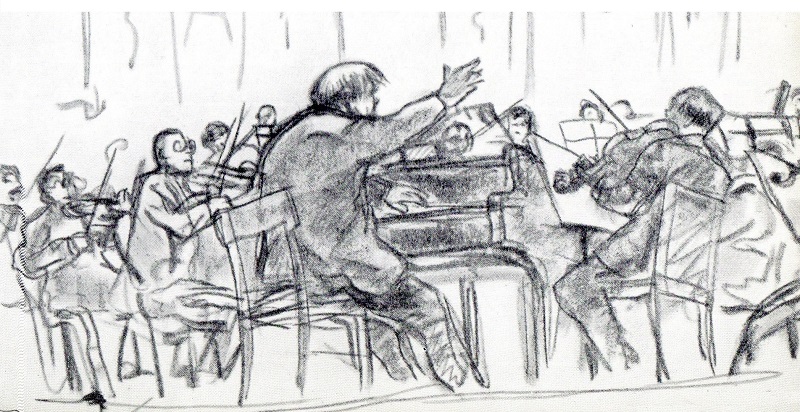
Maestro Editions qui a déjà publié le concert dirigé par Edwin Fischer lors du Festival de Strasbourg 1953, nous offre des inédits d’importance provenant cette fois du Festival de Salzbourg, où Fischer dirige les Wiener Philharmoniker. Il s’agit de la totalité du concert du 30 juillet 1951 (Mozart Concerto n°24 K.491, Haydn Symphonie n°104 et Beethoven Concerto n°1 Op.15) et du seul enregistrement qui subsiste du concert du 1er août 1949 (Beethoven Concerto n°4 Op.58).
Pour plus de détails, suivez ce lien:
Maestro Editions, which has already published the concert conducted by Edwin Fischer at the 1953 Strasbourg Festival, is now offering us some important previously unreleased material from the Salzburg Festival, where Fischer conducts the Wiener Philharmoniker. It is comprised of the entire concert of 30 July 1951 (Mozart Concerto No. 24 K.491, Haydn Symphony No. 104 and Beethoven Concerto No. 1 Op.15) and of the only surviving recording of the concert of 1 August 1949 (Beethoven Concerto No. 4 Op.58).
For more information, follow this link:
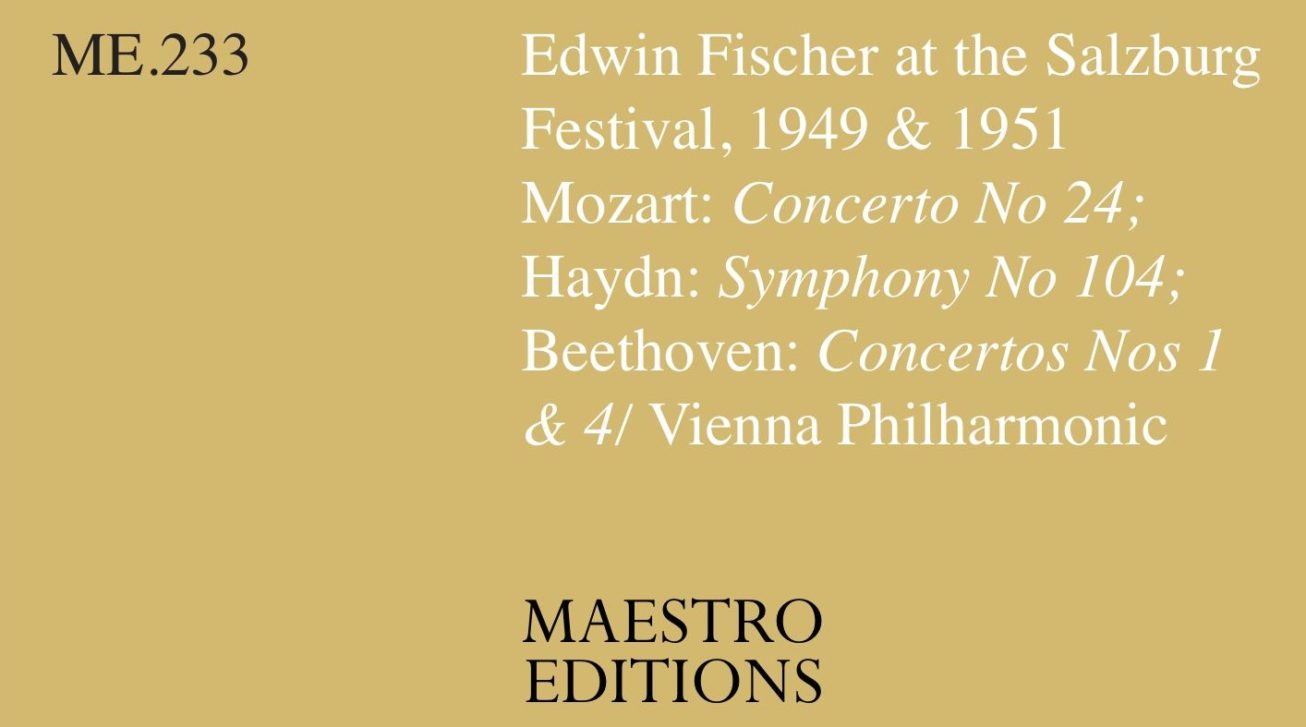

Mozart Quintet K.516
Quatuor Pro Arte
(Alphonse Onnou & Laurent Halleux, violon, Germain Prévost, alto, Robert Maas, violoncelle); Alfred Hobday, alto II
Abbey Road Studio n°3 – 15 February 1934
____________
Mozart Quartet K.478
Artur Schnabel, piano; Membres du Quatuor Pro Arte (Alphonse Onnoux, violon, Germain Prévost, alto, Robert Maas, violoncelle)
Abbey Road Studio n°3 – 31 January 1934
Source: 33t/LP Toshiba-EMI Angel Japan GR-2026
Voici deux enregistrements mozartiens du Quatuor Pro Arte, à savoir le chef d’œuvre absolu que constitue le Quintette en sol mineur K.516, couplé au Quatuor avec piano K.478, également en sol mineur, avec Artur Schnabel.
Pour le disque GR-2026 qui fait partie d’une série de rééditions japonaises en microsillons réalisée avec le plus grand soin à partir des matrices métalliques d’origine, il y a étonnamment peu de bruits de surface (sauf au début du Quatuor K.478).
Pour le Quintette K.516, la partie de deuxième alto est tenue par Alfred Hobday (1870-1942) qui a été le partenaire du Quatuor Pro Arte pour leurs enregistrements de Quintettes et de Sextuors (Mozart Quintettes K.515, K.516 et K.596, Brahms Sextuor n°1 Op.18), mais également du Budapest Quartet (Brahms Quintette n°1 Op.88 et Sextuor n°2 Op.36). Les faces enregistrées le 14 février 1934 (matrices 2B 6023-6029) ont toutes été rejetées et détruites, et le Quatuor a de nouveau enregistré le Quintette le lendemain (matrices 2B 6030-6037).
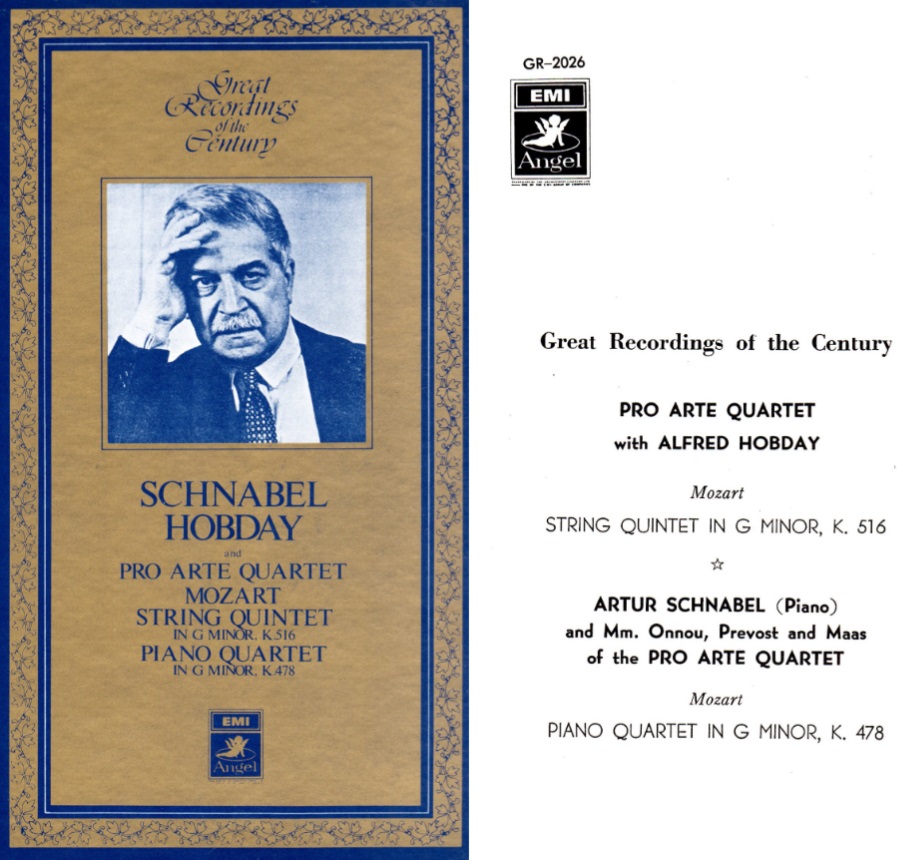
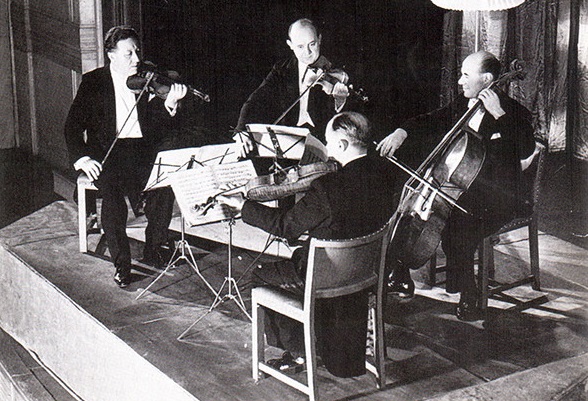
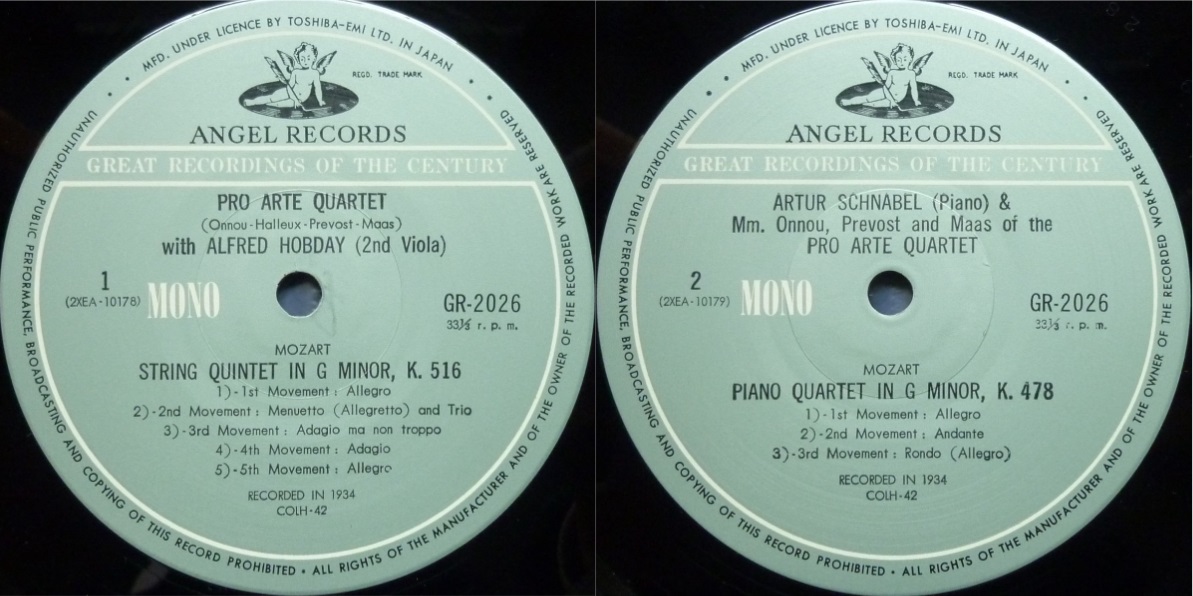
Here are two Mozart recordings by the Quatuor Pro Arte, namely the absolute masterpiece that is the Quintet in G minor K.516, coupled with the Piano Quartet K.478, also in G minor, with Artur Schnabel.
On the GR-2026 disc, one of a series of Japanese LP reissues made with great care from the original metal parts, there is surprisingly little surface noise (except at the beginning of the Quartet K.478).
In the Quintet K.516, the part of second viola is played by Alfred Hobday (1870-1942), who was the partner of the Pro Arte Quartet for their recordings of Quintets and Sextets (Mozart Quintets K.515, K.516 and K.596, Brahms Sextuor n°1 Op.18), but also of the Budapest Quartet (Brahms Quintet No.1 Op.88 and Sextet No.2 Op.36). The sides recorded on 14 February 1934 (matrices 2B 6023-6029) were all rejected and destroyed, and the Quartet recorded the Quintet again the following day (matrices 2B 6030-6037).
Les liens de téléchargement sont dans le premier commentaire. The download links are in the first comment
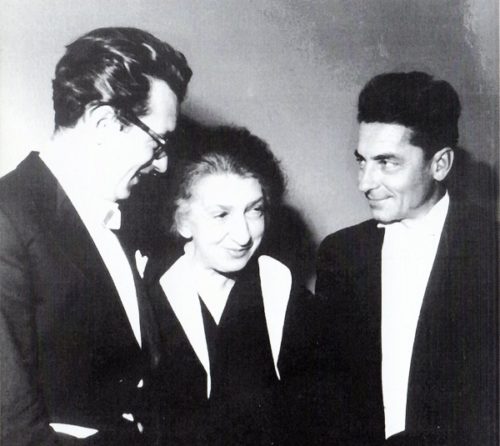
Mozart: Concerto n°10 K.365
Clara Haskil & Géza Anda – Philharmonia Orchestra Alceo Galliera
London Abbey Road Studio n°1 – 24-26 April 1956
Source Bande/Tape Columbia BTA109: 2 pistes/19 cm/s / 2 tracks 7.5 ips STEREO
Clara Haskil (1895-1960) a joué en duo avec Géza Anda à partir de 1954, mais ce n’est pas le premier pianiste avec lequel elle a formé un duo, ni celui avec lequel elle a joué le plus d’œuvres. En effet, en 1938-39, elle joué plusieurs fois avec Dinu Lipatti, et on trouve trace dans la presse suisse de concerts donnés à Vevey en 1944-45 avec Nikita Magaloff avec au programme, le 5 décembre 1944 sous la direction de Pierre Colombo, les deux Concertos qu’elle rejouera plus tard avec Anda (Bach: Concerto en ut majeur BWV1061 et Mozart: Concerto n°10 en mi bémol majeur K. 365), mais aussi, le 11 novembre 1945, la Sonate en ré majeur K.448 de Mozart, les Variations sur un thème de Haydn de Brahms, le Duettino Concertante de Busoni d’après Mozart, et enfin, après l’entracte et en ‘première audition’, la Sonate pour deux pianos et percussions de Bartók (sous la direction de Pierre Colombo avec Charles Peschier et Willy Blaser), dont le Finale a été bissé.
En 1958, Clara Haskil a commencé à s’entretenir avec Rita Wolfensberger, elle-même pianiste, en vue de la rédaction de ses mémoires. Le livre, écrit en allemand, est paru en 1961 (Alfred Scherz Verlag). Il est probablement le meilleur qui ait été écrit sur la pianiste, et il est dommage qu’il n’ait jamais été traduit. Il permet notamment de découvrir la véritable personnalité de Clara Haskil qui a été souvent présentée sous une forme stéréotypée par la presse musicale. Le récit de la rencontre avec Géza Anda est particulièrement révélateur:
‘En octobre 1953, Rolf Liebermann, alors directeur du département d’orchestre de la radio zurichoise, demanda à Clara Haskil de jouer la partie solo du Double Concerto de Mozart avec le jeune Hongrois Géza Anda (1921-1976), et c’est ainsi que se rencontrèrent deux pianistes de nature étrangement proche dans leur interprétation de Mozart. Le jeu de Clara était clair, perlé, celui d’Anda plus voilé, plus velouté; le rythme plus fluide, plus sinueux avec Haskil, celui d’Anda plus clairement accentué – mais le sens des nuances, l’amour de l’art raffiné, la capacité de créer de main de maître des ombres dans un cadre très étroit, tout cela était commun aux deux. Cette première collaboration a immédiatement entraîné d’autres engagements à deux, et un disque avec l’enregistrement de cette même œuvre et d’un Double Concerto de Bach sous la direction d’Alceo Galliera est sorti peu de temps après. Plusieurs Festivals se sont assurés la collaboration de ce magnifique duo; Keilberth, Karajan, Paumgartner et d’autres maîtres de la direction d’orchestre ont contribué à des performances artistiques de haut niveau.
Mais pour Clara, Géza Anda était bien plus qu’un fabuleux partenaire. Lui et son épouse pétillante devinrent des amis particulièrement précieux pour elle, et surtout pour leur nature extrêmement positive, optimiste et joyeuse. La jeunesse du tempérament de l’épouse de Géza était très précieuse pour Clara, tout comme elle se sentait toujours à l’aise et enjouée au contact des jeunes. Comme son dernier partenaire de violon Arthur Grumiaux (1921-1986), Anda avait plus de vingt-cinq ans de moins qu’elle. Lui et sa femme savaient parfaitement comment égayer leur amie plus âgée, mais restée jeune et naïve dans son cœur comme un enfant, et parfois aussi comment l’encourager et la pousser à toutes sortes d’imprévus. Si elle réagissait à tout moment aux plaisanteries avec un grand sens de l’humour, ce n’était pas seulement grâce à son heureuse capacité à entrer immédiatement dans n’importe quel jeu, mais aussi et surtout grâce au charme irrésistible avec lequel l’aimable et espiègle Anda pouvait proposer les idées les plus originales. Les deux artistes étaient très attachés l’un à l’autre, et le sourire qui planait sur leur relation d’amis et de collègues éclairait une profonde gravité humaine’.
Qu’il est dommage que le répertoire du duo Haskil-Anda soit resté limité à deux œuvres concertantes!
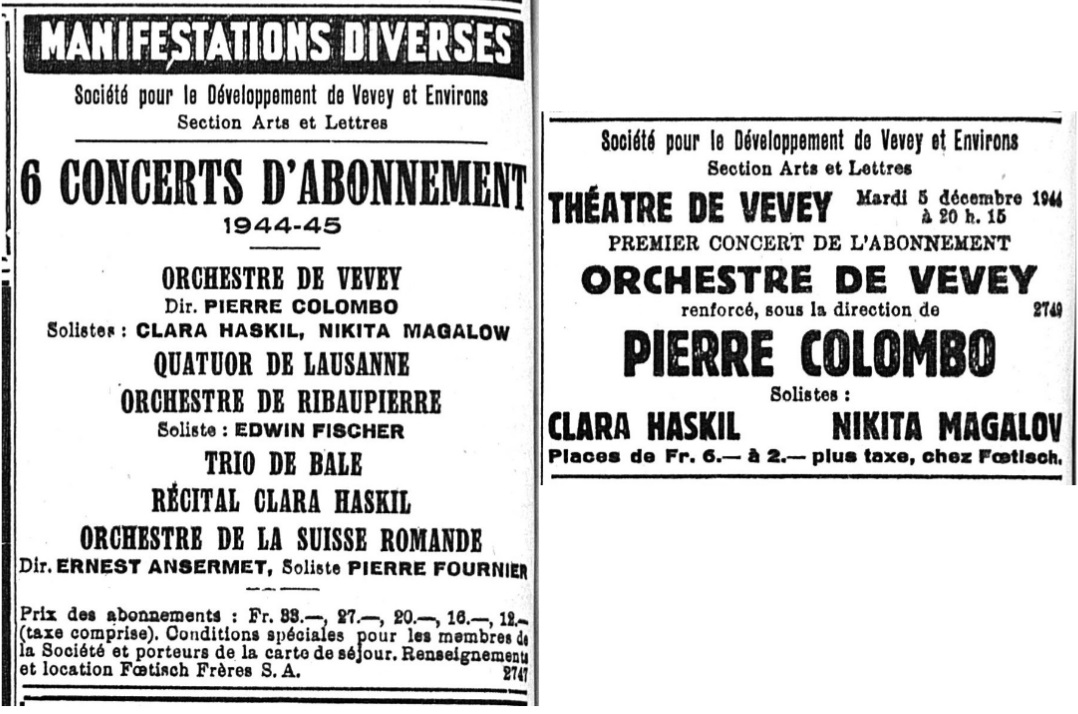
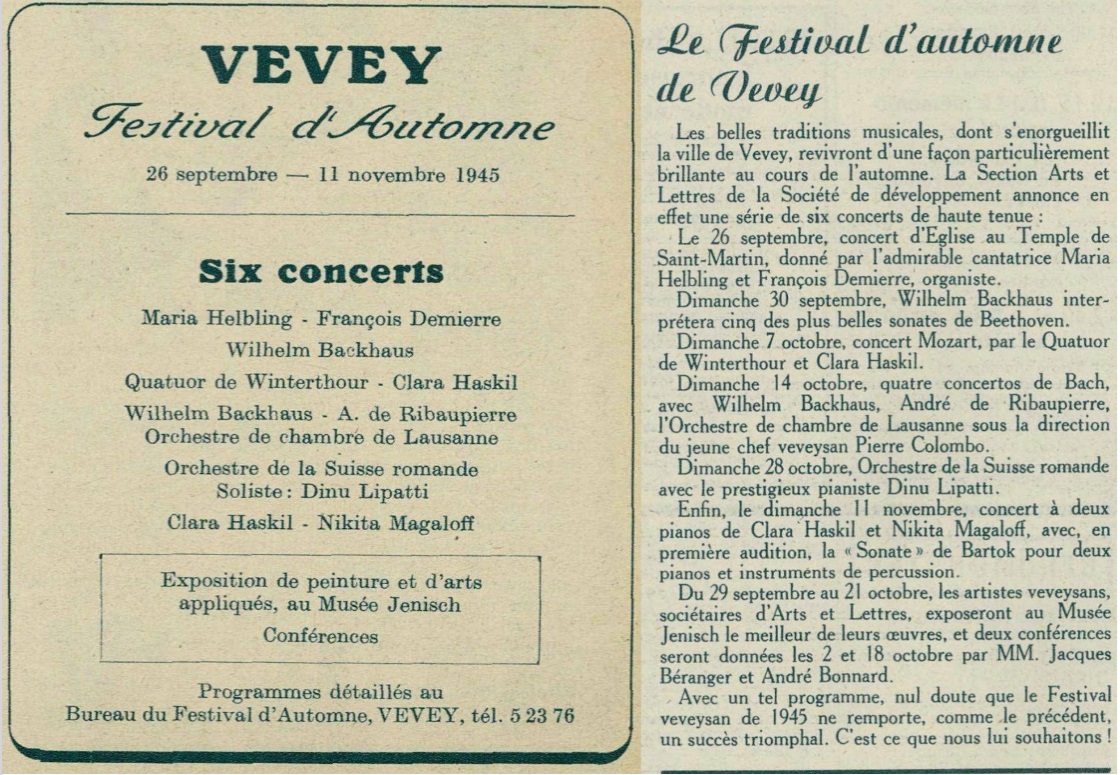
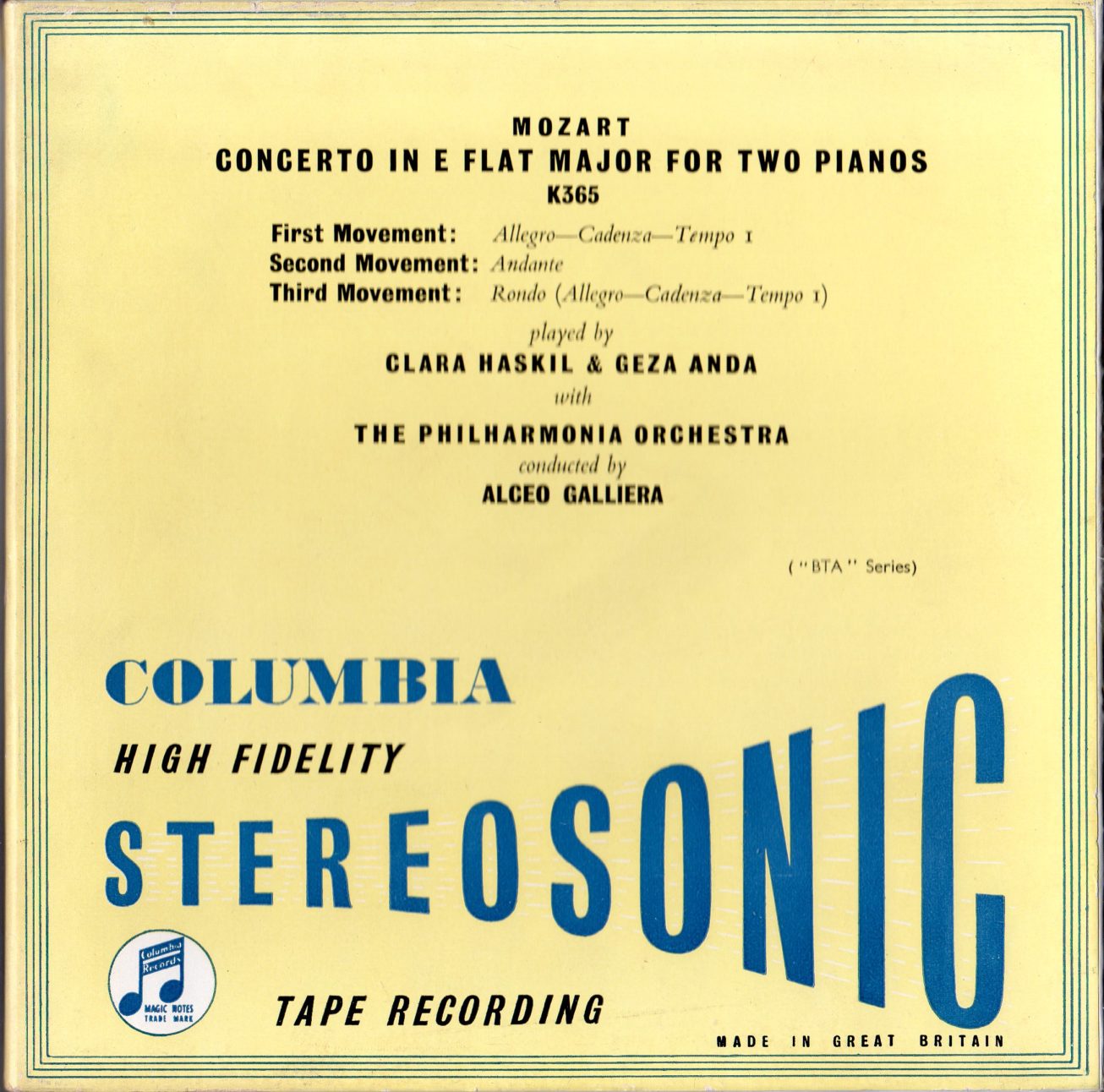
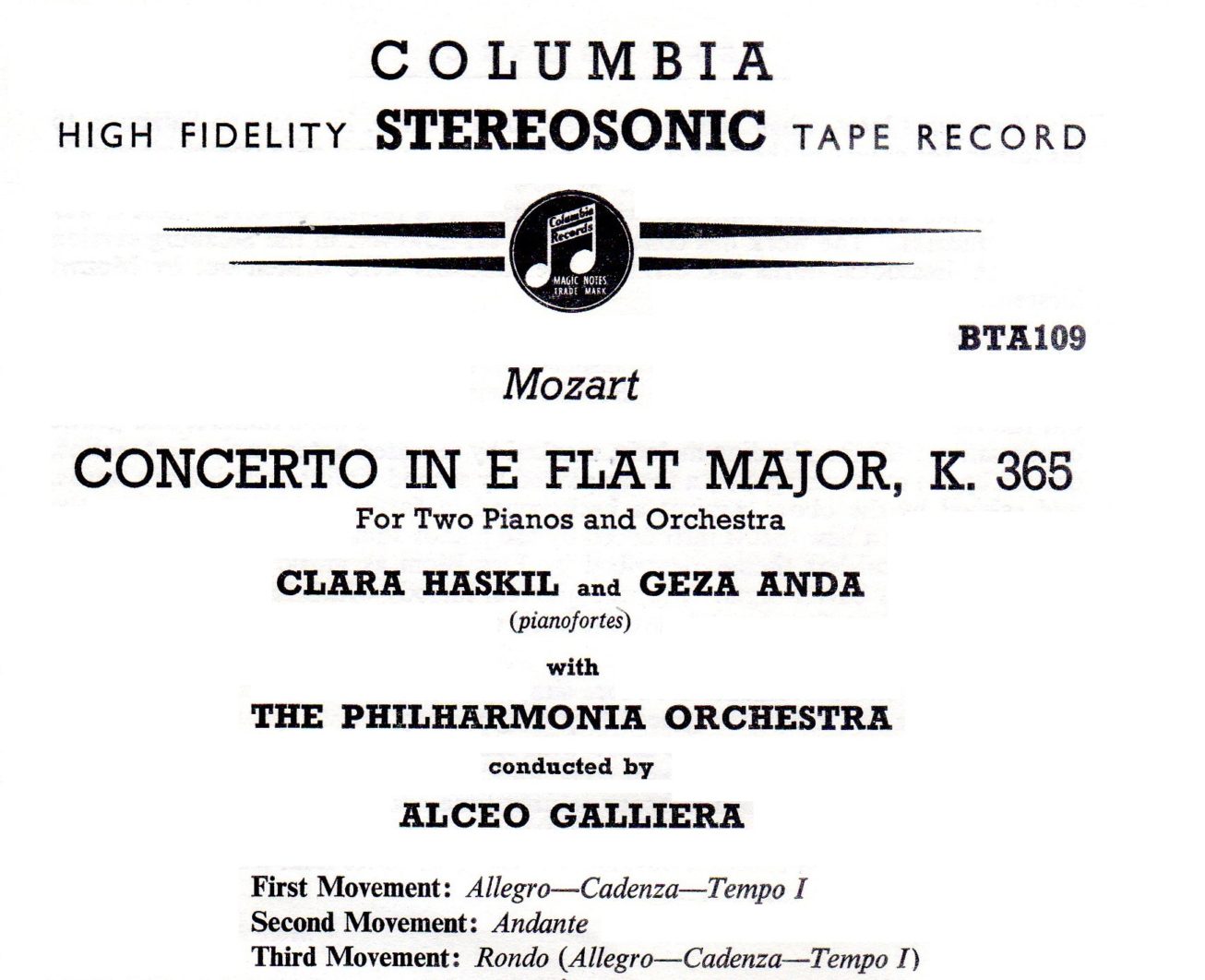
Clara Haskil (1895-1960) played together with Géza Anda from 1954, but he was not the first pianist with whom she formed a duo, nor the one with whom she played the most works. In fact, in 1938-39, she played several times with Dinu Lipatti, and the Swiss press records concerts given in Vevey in 1944-45 with Nikita Magaloff. On 5 December 1944, conducted by Pierre Colombo, the programme included the two Concertos she would later play with Anda (Bach: Concerto in C major BWV1061 and Mozart: Concerto No. 10 in E flat major K. 365), but also, on 11 November 1945, Mozart’s Sonata in D major K.448, Brahms’ Variations on a Theme by Haydn, Busoni’s Duettino Concertante after Mozart, and finally, after the interval and as a ‘first performance’, Bartók’s Sonata for Two Pianos and Percussion (conducted by Pierre Colombo with Charles Peschier and Willy Blaser), the Finale of which was encored.
In 1958, Clara Haskil started meeting Rita Wolfensberger, herself a pianist, with a view to writing her memoirs. The book, written in German, was published in 1961 (Alfred Scherz Verlag). It is probably the best ever written about the pianist, and it is a shame that it has never been translated. In particular, it reveals Clara Haskil’s true personality, which has often been presented in stereotyped form by the music press. The account of her meeting with Géza Anda is particularly relevant:
‘In October 1953, the then head of the orchestra department at Zurich Radio, Rolf Liebermann, asked Clara Haskil, together with the young Hungarian Géza Anda (1921-1976), to take on the solo part for a performance of Mozart’s Double Concerto, and thus two pianists met who were strangely close in their interpretation of Mozart. Each pianist’s playing was unmistakably characteristic: Clara’s touch was bright and sparkling, Anda’s more veiled and velvety; her rhythm more flowing and sinuous, Anda’s more clearly accentuated – but both shared a sense of nuance, a love of the fine art, the ability to shade masterfully within a very narrow framework. This first collaboration immediately led to further engagements as a duo, and a disc with a recording of this very work and of a Double Concerto by Bach under Alceo Galliera was released shortly afterwards. Festival venues secured the marvellous duo; Keilberth, Karajan, Paumgartner and other masters of conducting contributed to high level artistic performances.
For Clara, however, Géza Anda was more than just a marvellous partner. He and his cheerful wife became particularly precious friends to her, especially because of their extremely positive, optimistic and cheerful nature. The youthfulness of her temperament was a powerful attraction for Clara, just as she always felt at ease and exhilarated when socialising with young people. Like her last violin partner Arthur Grumiaux (1921-1986), Anda was more than twenty-five years her junior. He and his wife knew perfectky well how to cheer up their older friend, who remained as youthful and naïve at heart as a child, sometimes encouraging her and inspiring her to do all sorts of unexpected things. The fact that she always responded to jokes with a golden sense of humour was not only due to her fortunate ability to respond immediately to any play, but also primarily to the irresistible charm with which the lovable rogue Anda could come up with the most original ideas. Both artists were very close to each other, and the smiles that lay over their relationship as friends and colleagues masked a deep human seriousness’.
We can only regret that the duo’s repertoire remained limited to two Concertos!
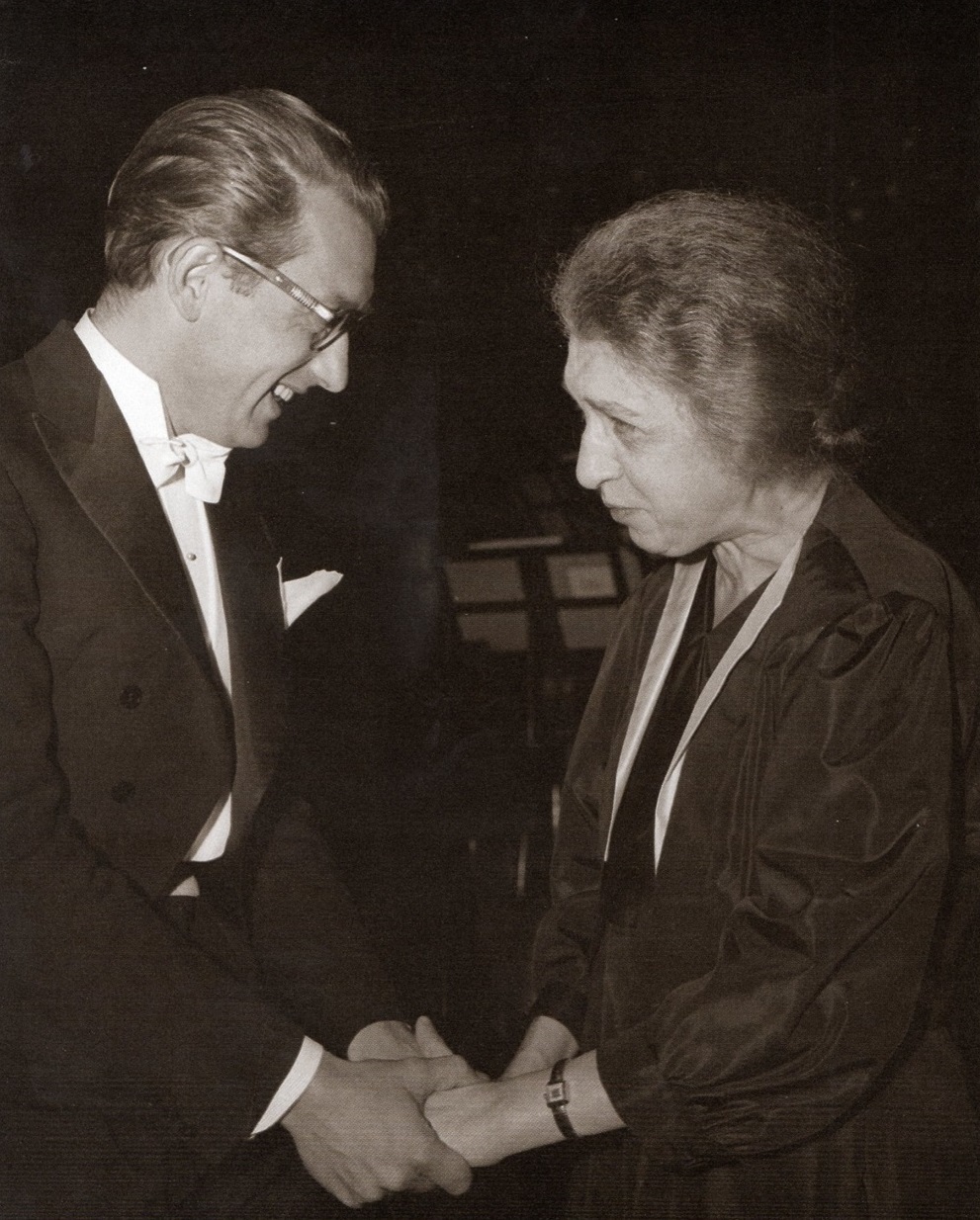
Anda & Haskil Luzern
Les liens de téléchargement sont dans le premier commentaire. The download links are in the first comment
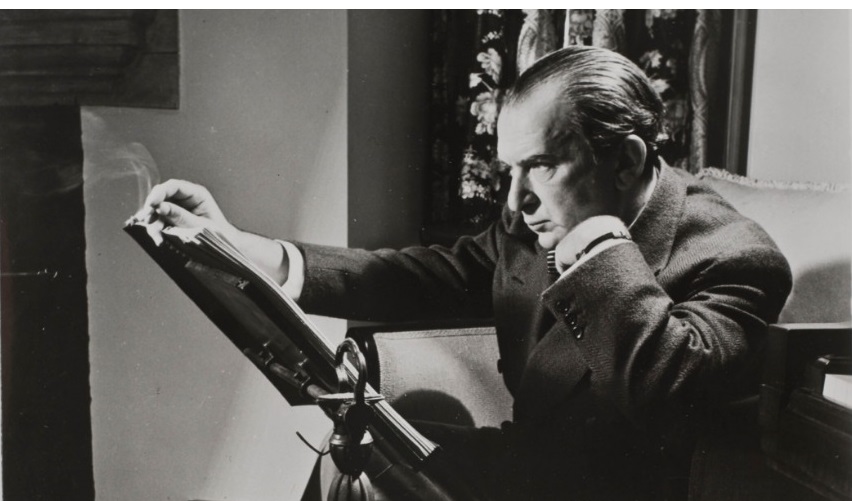
Fritz Reiner Chicago Symphony Orchestra (CSO)
Mozart Symphonie n°41 K.551
Chicago Orchestra Hall – April 26, 1954
Source Bande/Tape DCS-10: 2 pistes/19 cm/s / 2 tracks /7.5 ips STEREO
En octobre 1953, RCA a commencé à effectuer des enregistrements stéréophoniques expérimentaux en utilisant un magnétophone stéréo référencé RT-11 développé à cet effet par RCA. Les enregistrements stéréo de ‘Heldenleben’ et ‘Also sprach Zarathustra’ de Richard Strauss, réalisés à Chicago respectivement le 6 et le 8 mars 1954, ayant été un coup de maître, RCA a, très rapidement, commencé à les utiliser pour lancer la publication de bandes magnétiques stéréophoniques pré-enregistrées (ECS-1 en septembre 1954 pour ‘Also sprach Zarathustra’ et FCS-2 en juin 1955 pour ‘Heldenleben’). Les autres enregistrements réalisés à cette époque n’ont pas tardé à suivre, dont, en avril 1956, sous la référence DCS-10, cette symphonie de Mozart enregistrée le 26 avril 1954. Le catalogue de juillet 1957 témoigne de l’intérêt suscité par cette nouvelle technique.
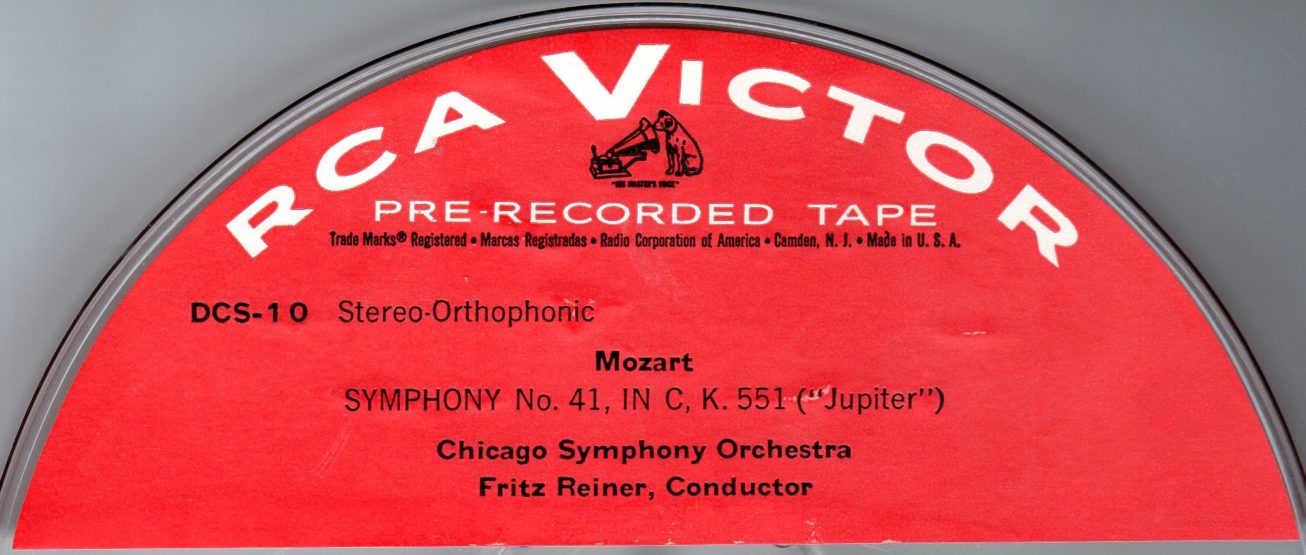
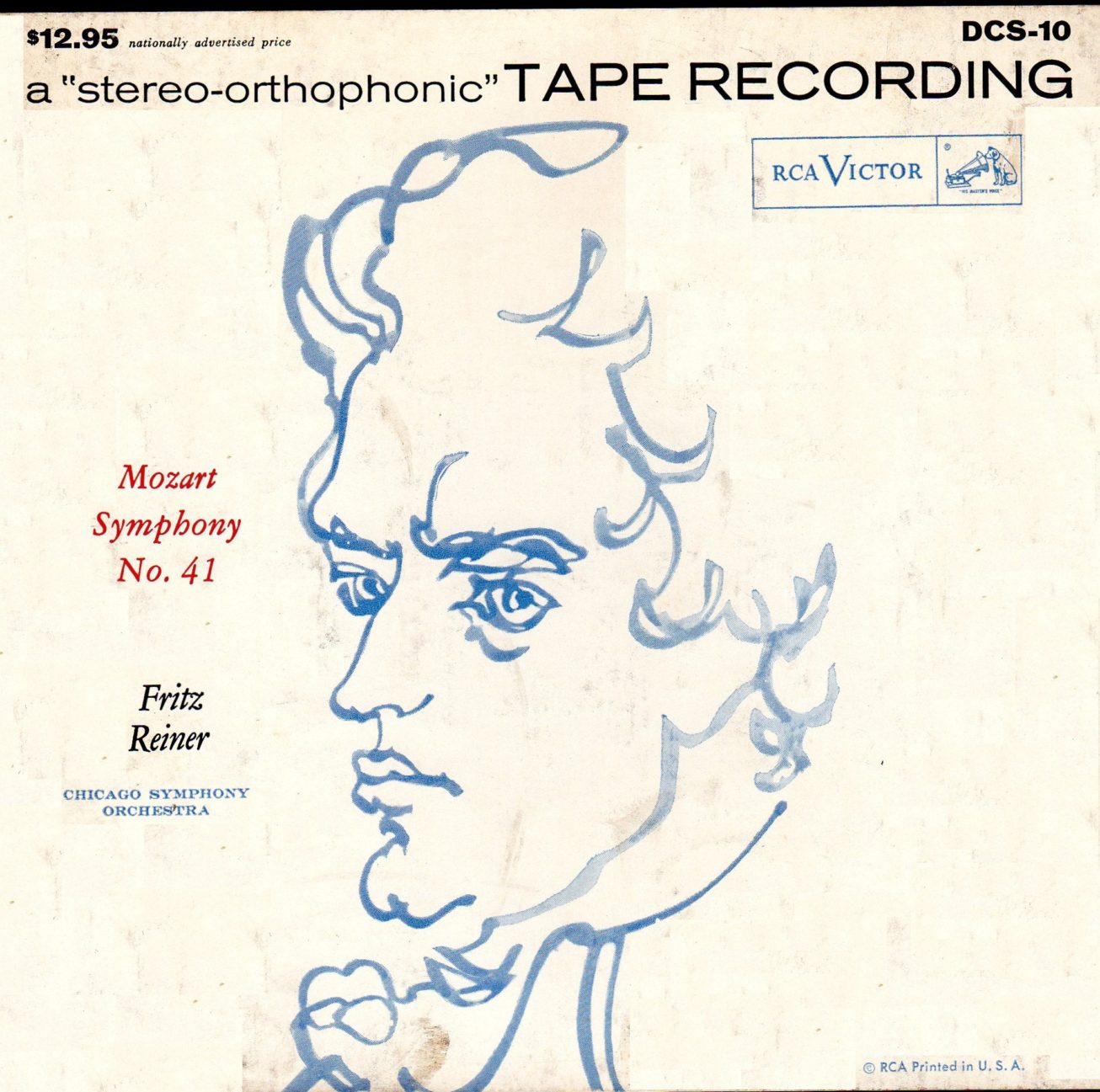
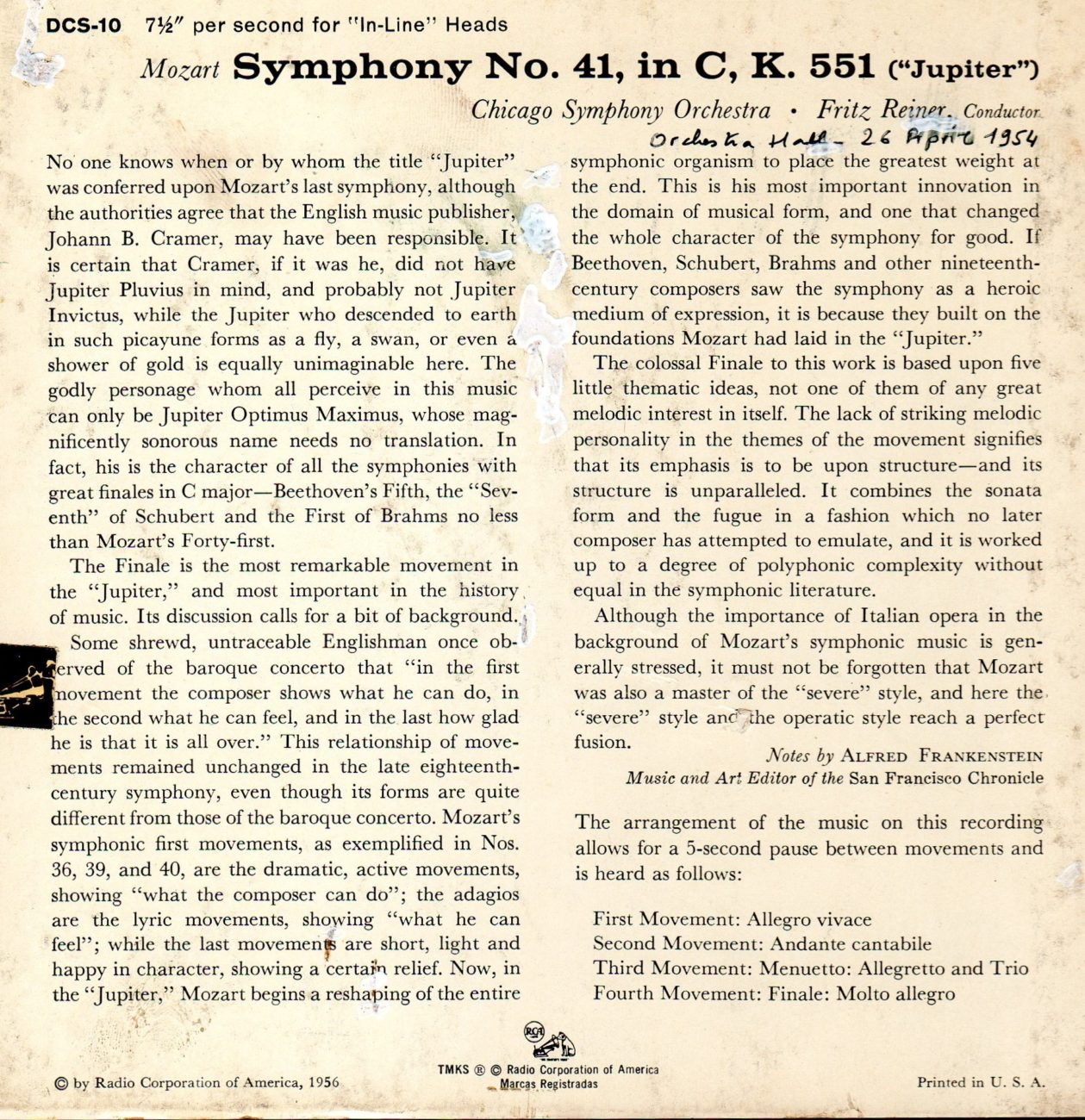
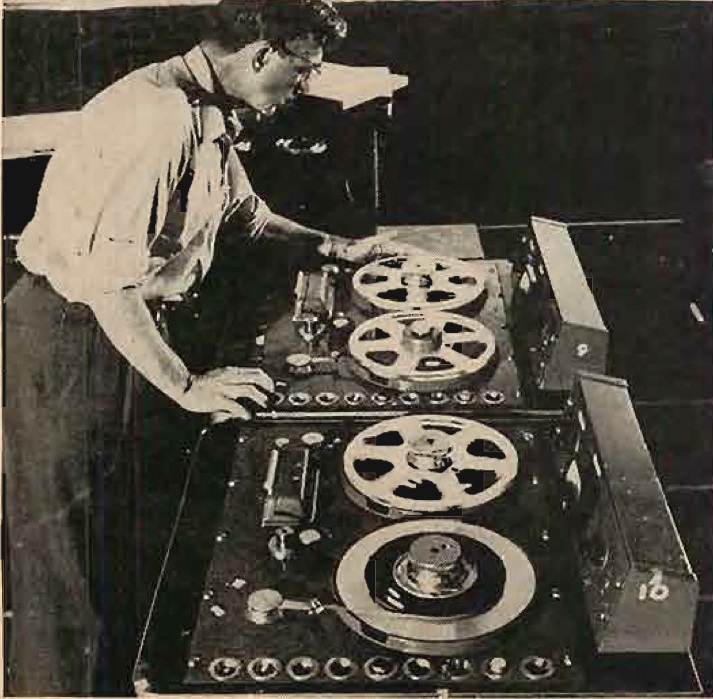
RCA Victor’s first two-track stereo recorders Model RT-11 (1954)
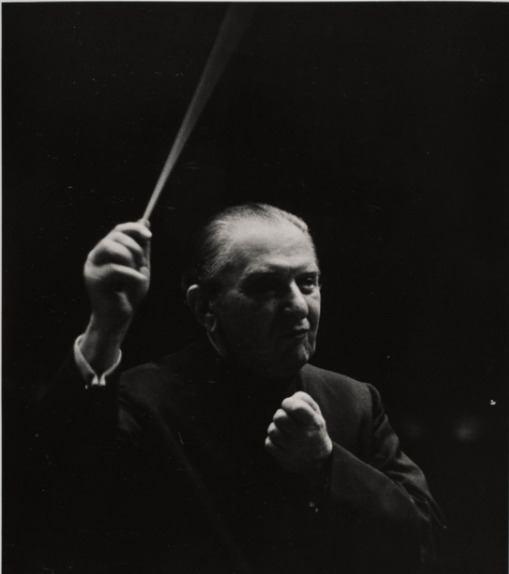
 Tape-Recording – October 1956 Review Tape DCS-10
Tape-Recording – October 1956 Review Tape DCS-10
In October 1953, RCA began making experimental stereophonic recordings using a stereo tape recorder, RT-11, developed by RCA for this purpose. The stereo recordings of Richard Strauss’s ‘Heldenleben’ and ‘Also sprach Zarathustra’, made in Chicago respectively on March 6 and 8, 1954, were a masterstroke, and RCA very quickly began using them to launch the publication of pre-recorded stereophonic magnetic tapes (ECS-1 in Septembre 1954 for ‘Also sprach Zarathustra’ and FCS-2 in June 1955 for ‘Heldenleben’). The release of the other recordings made at this time soon followed including, in April 1956, under the reference DCS-10, this Mozart symphony recorded on April 26, 1954. The July 1957 catalog testifies to the interest aroused by this new technique.
Les liens de téléchargement sont dans le premier commentaire. The download links are in the first comment



